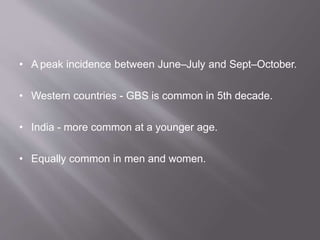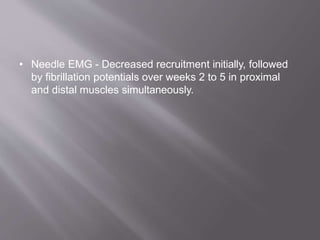Aidp
- 2. • Acute Onset • Usually Monophasic • Immune mediated disorder • Peripheral Nervous System
- 3. GBS = AIDP New Concept Other Variants
- 4. • First described by Landry in 1859. • Recognized as GBS since 1916, when Guillain, Barre´, and Strohl described two French soldiers who contracted the illness during World War I.
- 5. • Incidence Rate : 1–2 / 100,000 population. • The lifetime likelihood of any individual acquiring GBS is 1:1000. • In Europe and North America : AIDP(90% of the cases). • In China and Japan : AMAN(most common).
- 7. • A peak incidence between June–July and Sept–October. • Western countries - GBS is common in 5th decade. • India - more common at a younger age. • Equally common in men and women.
- 8. • Often follows an upper or lower respiratory illness or gastroenteritis by 10 to 14 days. • Approximately 70% of patients can identify a preceding illness. • Infections associated with GBS - CMV, M. pneumoniae, EBV, Influenza A, H. influenzae, Enterovirus, Campylobacter jejuni and Zika virus.
- 9. • Cytomegalovirus : most common associated virus. • Campylobacter jejuni : most frequently associated bacterial infection.(overall 40%) • Other less common precipitants are surgery, pregnancy, cancer, and vaccinations.
- 10. • Evolves over days, often beginning with numbness in the lower limbs and weakness in the same distribution. • Approximately 50% of patients achieve maximum weakness by 2 weeks, 80% by 3 weeks, and 90% by 4 weeks. • Progression beyond 4 weeks is unusual. • Neuropathic pain - 66% patients(localized to the lower back and thighs).
- 11. • The weakness begins distally and spreads proximally. • In rare cases, the weakness may be localized to the legs only (giving the appearance of paraplegia). • Sensory examination : normal or show minor deficiencies in vibration and proprioception. • All patients have areflexia or at least hyporeflexia at some time in the illness.
- 12. • 50% of patients - some degree of facial weakness. • Weakness attributed to cranial nerves includes ocular dysmotility, pupillary changes, and ptosis. • Ophthalmoparesis : approximately 20% of patients with GBS.
- 13. • 30% of patients develop respiratory failure from phrenic nerve disease, requiring intubation and ventilation. • Autonomic involvement : tachycardia, bradycardia, hypertension and hypotension, gastric hypomotility, and urinary retention.
- 15. • An axonal motor variant of GBS • Reported in 1993 from Northern China • So K/As Chinese paralytic illness. • Can present with transient conduction block without axonal loss and this led to the term acute motor conduction block neuropathy.
- 16. • More common in children during the summer. • Pure motor without sensory symptoms and signs. • NCS – decreased CMAP amplitudes, normal latencies and conduction velocities, and normal sensory studies.
- 17. • Sensory involvement also occurs • Later age of onset • Broader geographic distribution • A more protracted course • Slower and incomplete improvement
- 18. • Acute or subacute demyelinating polyradiculoneuropathy. • Clinical presentation differs markedly from typical AIDP. • Triad of ophthalmoplegia, areflexia, and ataxia. • Often grouped with Bickerstaff brainstem encephalitis - similar presentation plus encephalopathy and corticospinal tract dysfunction.
- 19. • The prognosis in both Miller Fisher syndrome and Bickerstaff brainstem encephalitis is favorable. • Most patients improve within 1 to 2 months and make a complete recovery in 6 months even without specific treatment.
- 20. • Rare • Sympathetic and parasympathetic nervous systems involved. • CVS involvement, Blurry vision, anhydrosis. • Recovery is often gradual and incomplete. • Often combined with sensory features.
- 21. • Molecular mimicry plays a major role. • Molecular mimicry is believed to occur where the immune system recognizes the myelin epitope as ‘‘foreign’’ and targets it for destruction.
- 26. • Elevated CSF protein - may not be present until 3 weeks after the onset of the illness. • Pleocytosis (greater than 5 white blood cells) - not present in patients with GBS • 15% of patients -10 to 50 cells per high-power field. • If a pleocytosis is present, it raises suspicion for an infectious process; sarcoidosis; or carcinomatous or lymphomatous meningitis.
- 28. • In first few days – NCS may be normal or only show subtle changes of demyelination, such as prolonged or absent F waves and H reflexes, and patchy changes in distal latencies in patients with AIDP. • As the disease evolves - conduction block, temporal dispersion, and prolonged distal and F-wave latencies.
- 29. • Sensory NCS - A characteristic sural nerve sparing. • Sensitivity of NCS - As low as 22% in early AIDP and rise to 87% at 5 weeks. • A conduction velocity of <70% of the lower limit of normal and a distal latency of >150% of the upper limit of normal was highly sensitive and had a specificity of nearly 100% for AIDP.
- 30. • Needle EMG - Decreased recruitment initially, followed by fibrillation potentials over weeks 2 to 5 in proximal and distal muscles simultaneously.
- 31. • The best electrodiagnostic indicator for a rapid or good recovery is maintained motor amplitude. • Patients with an average amplitude >10% of the lower limit of normal likely have a major component of conduction block which has the potential to reverse. • Amplitudes <10% during illness are seen in patients with a greater degree of axonal injury and a more prolonged recovery.
- 32. • To assess for gadolinium enhancement of nerve roots. • To eliminate other causes of quadriparesis, particularly transverse myelitis, subacute compressive myelopathy, and infiltrating illnesses of the roots and the spinal cord. • 95% of children with GBS show enhancement of the lumbar roots secondary to the inflammatory process.
- 40. • (1) time from GBS onset to hospital admission of less than seven days • (2) inability to lift the elbows or head above the bed • (3) inability to stand • (4) ineffective coughing
- 42. • Plasma exchange • IVIg • Corticosteroids(not approved)
- 43. • First treatment shown to be effective. • Removes autoantibodies, immune complexes, complement, and cytokines. • Boosts T-cell suppressor function. • Dose - 250 mL/kg divided over 5 alternating days. • Risks - central venous catheter placement, hypotension, cardiac arrhythmia, vasovagal spell, allergic reaction to albumin replacement, hypocalcemia, anemia, and thrombocytopenia.
- 44. 2017
- 45. Patients with mild GBS on admission should receive 2 PEs. Patients with moderate and severe forms should benefit from 2 further exchanges.
- 46. • Pooled IgG from thousands of blood donors, which results in a fivefold increase in serum IgG. • Adverse events - mild infusion-related symptoms (nausea and headache), aseptic meningitis, rash, severe rare anaphylaxis, and, in fewer than 2% of cases, renal failure. • IVIg may be preferred since it is easier to administer.
- 47. IVIg is as effective as plasma exchange. NEJM 1992
- 48. Lancet 1997
- 49. 2016
- 51. • PE is recommended for nonambulant patients within 4 weeks of onset (level A, class II evidence) and for ambulant patients within 2 weeks of onset (level B, limited class II evidence). • The effects of PE and IV immunoglobulin (IVIg) are equivalent. • There is insufficient evidence to recommend the use of CSF filtration (level U, limited class II evidence).
- 52. • The evidence is insufficient to recommend the use of immunoabsorption (level U recommendation, class IV evidence). • IVIg is recommended for patients with GBS who require aid to walk within 2 (level A recommendation) or 4 weeks from the onset of neuropathic symptoms (level B recommendation derived from class II evidence concerning PE started within the first 4 weeks and class I evidence concerning the comparisons between PE and IVIg started within the first 2 weeks).
- 53. • The effects of IVIg and PE are equivalent. • Corticosteroids are not recommended for the treatment of patients with GBS (level A, class I evidence). • PE and IVIg are treatment options for children with severe GBS (level B recommendation derived from class II evidence in adults).
- 55. • Inhibition of complement using eculizumab prevents neuropathy in an animal model of Miller Fisher syndrome. • Limitations - significant cost and potential complications, including a high risk of meningococcal infections. • Other complement inhibitors - APT070, rEV576, nafamostat mesylate, and soluble complement receptor 1 have been evaluated in animal models.
- 56. • One possible strategy for axon protection is sodium channel blockade. • Supporting this approach are data indicating flecainide protects axons in an animal model (experimental autoimmune neuritis [EAN]). • Another general approach to axon protection, or enhanced regeneration, is growth factor therapy.
- 57. • The voltage gated potassium antagonist, 4 aminopyridine represents a potential approach for GBS patients with residual gait dysfunction.
- 58. • Treatment-related fluctuations are defined as worsening of weakness after an initial improvement or after stabilization following treatment with IVIg or plasma exchange. • Occur in approximately 10% of patients with GBS. • Usually take place within the first 2 months after treatment. • Treated with another course of IVIg or plasma exchange, and the treatment is often beneficial.
- 59. • If the patient experiences more than one treatment- related fluctuation, and particularly if it occurs 2 months or more after the onset of the illness, then the diagnosis of CIDP becomes a strong consideration.
- 60. • The prognosis for most patients with GBS is for good to excellent recovery. • Approximately 87% experience full recovery or minor deficits. • Most of the improvement in GBS occurs within the first year, but patients may continue to improve for up to 3 years or longer.
- 61. • Mortality in GBS is 3% to 7% • Most often attributable to respiratory failure, infection, or uncontrollable autonomic dysfunction.
- 64. • New variants • Diagnostic and prognostic criteria have come • Newer treatment modalities under trials
- 66. • Guillain-Barre´ Syndrome. P D Donofrio. Continuum 2017;23(5):1295–1309. • Acquired Immune Demyelinating Neuropathies. M M Dimachkie. Continuum 2014;20(5):1241–1260. • Immune-Mediated Neuropathies. Y T So. Continuum Lifelong Learning Neurol 2012;18(1):85–105. • Guillain-Barré Syndrome. X A Londono et al. Semin Neurol 2012;32:179–186. • Inflammatory Neuropathies. J Whitesell. Semin Neurol 2010;30(4):356-364.
























































![• One possible strategy for axon protection is sodium
channel blockade.
• Supporting this approach are data indicating flecainide
protects axons in an animal model (experimental
autoimmune neuritis [EAN]).
• Another general approach to axon protection, or
enhanced regeneration, is growth factor therapy.](https://image.slidesharecdn.com/aidp-210821074949/85/Aidp-56-320.jpg)









